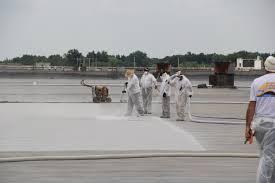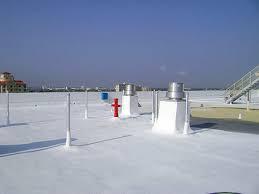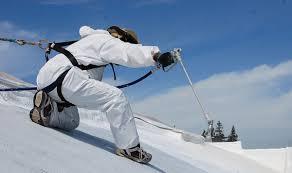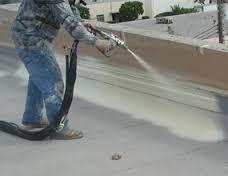Spray Foam Roofing -
Sprayed Polyurethane Foam (SPF)
Spray Polyurethane Foam (SPF) is a form of plastic that goes from liquid to solid in a matter of seconds, increasing in volume approximately 30x as it dries. It is the most cost-effective and sustainable roofing, insulation and waterproofing system available today.

SPF is very low in the emission of Volatile Organic Compounds (VOCs).
It is free from chlorofluorocarbons (CFCs) – which have been shown to adversely affect stratospheric ozone.
It is the most energy-efficient form of insulation there is.
It eliminates the need for costly roof tear-offs and the burden this places on landfills.
Versatility: The physical properties of SPF can be varied according to the purposes to which it is put. Its texture can range from soft to semi-rigid to high-density roofing foam that can sustain the pressures of heavy weather, heavy equipment and heavy human traffic – indefinitely.
Both light weight and strong, SPF can increase the structural strength of airplane wings and can be used as a floating dock for sea-going barges. A partial list of its many residential, commercial, industrial and manufacturing applications includes:
Construction Industry: Roofing and roof stabilization – plus insulation for walls, ceilings, attics and basements. Because it is composed of billions of closed cells, the foam acts as an air barrier, reducing moisture infiltration, which is the leading cause of building deterioration.
Tankage and Refrigeration: For any market sector that requires insulated cooling or freezing facilities and storage containers – including the wine, agricultural, recreational, oil, gas and chemical processing industries.
Transport: SPF is used to insulate shipping containers for planes, trains, trucks, trawlers and tankers.
Whether used in refrigerated container ships or small pleasure crafts, large industrial freezers or display cabinets for private collectors of rare wines or books, SPF has proven itself to be the best insulation available today.

Why We Use SPF on Roofs
SPF roofs last indefinitely and hold their insulation value forever. They withstand extraordinary weather events – which is why SPF was chosen for the new roof on the Louisiana Superdome.
When compared to other roofing systems having the same R-value, slope considerations and warranty, SPF roofs are usually more economical. When the life cycle costs of all roofing systems are compared, SPF is the most economical choice by a very wide margin.
Warranties
Numerous warranties are available from Brazos and our vendors depending on the need and desires of the end user. From coating warranties to full system 20-year warranties including a guarantee that the roofing system will not become disbonded from the substrate in ANY WIND EVENT, are available throughout the United States and abroad.
SPF on roofs –
Can be applied rapidly with little or no disruption to the facilities.
Requires fewer people to apply – which reduces the likelihood of accidents.
Eliminates the need for multiple levels of roofing required by conventional systems.
Conforms to all roof shapes and types.
Can be applied directly over asphalt, shingles, built-up roofs, clay tile, concrete, metal and wood.
Produces energy savings of 30% compared to alternative roofing systems.
Evens out roof surfaces so there are no dips where water can collect.
Self-flashing and seamless – therefore no leaks.
Is highly resistant to chemical attack.
Requires minimal upkeep to remain under warranty.
Lasts forever if properly maintained.
Elastomeric Coatings: To further weatherproof a structure – and enhance its capacity to sustain normal seasonal expansions and contractions – we finish each job by applying a UV resistant coating system with a granular surface. Our elastomeric coatings have outstanding durability and low-temperature flexibility. They have very little odor and low VOC emissions.
New penetrations in the roofing system are easily installed and become a part of the warranted roofing system.
As the cost of energy increases, so will the demand for SPF roofs. Brazos is an industry leader in SPF for roofing and every other application of this amazingly safe and useful material.The SPF roof system
Spray polyurethane foam (SPF or "foam") roof systems provide a seamless, monolithic application. The roof system has excellent adhesion properties and can be an outstanding roof system where wind uplift is a concern.

The process
Spray polyurethane foam roofs are applied in a two-part liquid process that dries quickly to form a seamless waterproof barrier. This barrier adds insulation and can be field fabricated to provide taper and slope so the roof can drain effectively. Spray foam roofs provide increased insulation and reflectivity and, among other various attributes, are fire resistant.
Coating
Once the roof is installed, it is then coated. The coating protects the polyisocyanurate "foam" from ultraviolet degradation. The roof coating can be installed with one of many products: silicone coating, urethane coating, polyurea coating or an acrylic coating. CentiMark can apply all coatings. For added protection and slip resistance, granules can be broadcasted into the roof coating. CentiMark can also provide a cementitious layer that can be used as the coating over the spray polyurethane foam roof system. This provides a very durable finish that is excellent for high traffic roof areas.
The Truth About SPF
Over the years, sprayed polyurethane foam has collected a few misunderstood characteristics. Below are some critical pieces of information that debunk many of the myths you may have heard about SPF. Before you decide what material to use on your next project,
Myth: Sprayed polyurethane foam won’t last.
Reality: Research has shown that SPF roofs are long-lasting, successful systems that can last up to 50 years when applied and maintained with periodic low cost elastomeric re-coats.. The National Roofing Foundation (NRF) performed a study in 1995 at Arizona State University that supported extremely high customer satisfaction and durability related to SPF materials.
Myth: SPF is not a proven material for roofing or other insulation.
Reality: Sprayed polyurethane foam technology has been around for more than 50 years, since it began to be distributed commercially in 1954. Polyurethane technology was initially used for refrigeration and industrial insulation projects, and has been perfected for use in residential and commercial applications of all kinds. Spray foam application is now prescribed for roofing and insulation needs all over the world and is applied with precision parameters for successful applications. The material is recognized by the National Building Code and has been proven to reduce penetrations to the building envelope.
Myth: Spray foam roofs can’t be walked on.
Reality: You absolutely can walk on spray foam roofs. Both the Spray Polyurethane Foam Alliance (SPFA) and National Roofing Contractors Association (NRCA) assert that SPF roofs, when applied correctly can sustain up to 40 pounds per square inch or higher. A foam roof is capable of supporting the weight of any normal person, although any extremely sharp object could leave a hole that compromises the building envelope.
Myth: SPF can only be applied in perfect weather.
Reality: Sprayed polyurethane foam has been successfully installed all over the world, including every geographic region within the United States. The ideal temperature for the installation of an SPF system is between 60 and 120 degrees farenheit — the same requirement as any other roofing application. While any good SPF contractor pays very close attention to moisture levels, temperature, humidity and wind factors, Thermal Roof Systems knows exactly how to maximize weather variables to get the job done quickly and seamlessly in any geographic region.
Myth: Spray foam is too difficult to apply correctly.
Reality: Thermal Roof Systems is aptly certified to install spray foam systems efficiently and seamlessly to ensure the desired results. Over 500 contractors in the US are certified to install sprayed polyurethane foam roofs, but no one takes as much care to thoroughly train and certify every installer as TRS does.
Myth: Insurance companies will not insure SPF roofing systems
Reality: SPF roofing systems are fully insurable and tested extensively at independent laboratories. For a list of recommended insurers, speak with a TRS representative.
Myth: All SPF roofs are the same
Reality: TRS can attest that unqualified and careless contractors have poorly applied foam materials, resulting in defective systems. By selecting a meticulous, experienced spray foam contractor, the results will be vastly different. Once the best materials are specified by design professionals, it is important to select the most qualified, experienced SPF installer in order to achieve maximum results. TRS spends considerable time preparing roofing and insulations services to achieve maximum results.
Myth: Foam roofs are too expensive
Reality: Sprayed polyurethane foam is actually one of the most affordable roofing and insulation solutions, especially when you consider the cost savings associated with choosing SPF. Rising oil prices over the last decade have driven up the costs of other flat roof alternatives, while the cost of foam roofing has remained consistent. Once you incorporate the savings associated with a durable, long-lasting material, the extended life provided by elastomeric coatings, and energy cost savings, foam proves to be an extremely cost effective option.
Specifying SPF Roofing Systems
Is a spray polyurethane foam system right for your next roofing project? Find out now.
In today’s buildings industry, there is a growing desire to provide owners with durable, long-lasting roofing systems that combine high energy performance with low maintenance costs. From that desire, a renewed interest in SPF roofing systems has risen. SPF roofing systems have been around for more than 40 years; however, there is still a significant lack of knowledge among many roofing professionals on how to specify, install, or maintain these systems.
What is spray polyurethane foam roofing?
Spray polyurethane foam (SPF) roofing consists of an application of specifically designed foam covered with an elastomeric coating (typically acrylic, silicone, or polyurethane) or aggregate covering to protect the foam from ultraviolet rays. Specialized equipment mixes two liquid components at the spray gun that applies the SPF to a prepared substrate. The mixed liquid expands many times its original volume in a matter of seconds, forming a rigid foam plastic that chemically bonds to the surface to which it is sprayed. Spraying the foam in Ú½-inch to 1Ú½-inch lifts allows the applicator to reach the desired thickness to fill in low areas, build up slope, and provide insulation.
SPF has a closed-cell structure that makes it water resistant. It must, however, be protected by elastomeric coatings or other coverings (such as aggregate) to prevent ultraviolet-induced surface degradation. Such coverings can also be used for other purposes, including inhibiting moisture vapor transmission, enhancing the aesthetics of the system, increasing the impact and abrasion resistance of the system, and achieving flammability and code requirements.
What type of life should I expect from a SPF roof?
In 1996 and 2003, the National Roofing Foundation commissioned Dr. Rene Dupuis of Structural Research Inc. to conduct research on SPF roofing systems in six different climate zones in the United States. Based on surveys of over 300 SPF roofing systems, Dupuis concluded that SPF roofs have an effective service life of more than 30 years. The research also shows that the physical properties of the foam change very little with age. This indicates that the life expectancy of a SPF roof system depends primarily on the original application and long-term maintenance.
SPF roofing systems should be inspected semi-annually and after events that could cause mechanical damage, such as hail storms, tornados, and hurricanes. Small (less than 4-inch in diameter) cracks, gouges, or punctures can be repaired with an elastomeric sealant compatible with the SPF system. To repair more extensive damage, remove the damaged foam and reapply additional SPF and coating.
SPF roofing systems typically are recoated at regularly scheduled intervals to extend the life of the system. According to Dupuis’ research, SPF roofing systems currently average 15 years between recoating cycles.
Where is SPF used?
SPF roofing systems have good adhesion to a variety of substrates, including metal, wood, concrete, and built-up roofing (BUR). Since SPF adds little weight to existing roof coverings and can build slope to fill in low areas, these systems are used frequently as a recover roofing system. Caution should be used when specifying any recover roofing system. The existing roof covering and roof deck assembly should be thoroughly evaluated to verify that it can be a good substrate for SPF roofing systems.

Hail and wind-driven missiles (such as tree limbs, broken roof tile, metal flashing, etc.) can damage the SPF roofing system. However, this type of damage typically does not cause leaks and can be repaired later without compromising the long-term performance of the system. SPF roofing systems also excel when the following conditions exist:
Additional insulation is required.
There are severe temperatures.
The roof substrate has numerous penetrations.
The roof deck is an unusual configuration.
The roof is in an area where high winds are likely to occur.
Lightweight materials are required.
Slope must be added to provide positive drainage.
Because of the energy-saving characteristics and low maintenance costs of SPF roof systems, these roofs are suited to companies or organizations that own their own buildings and must pay their own energy and maintenance costs.
What are the limitations of SPF roofing systems?
Warning: Knowledge and experience are required. A relatively small crew can install large SPF roofing systems, but it requires a high degree of technical knowledge and experience. Years ago, there were fewer trained contractors and less training available. Today, many courses are available from suppliers and from the Spray Polyurethane Foam Alliance (SPFA) to shorten the learning curve.
When incorrectly installed, SPF roofing systems often exhibit interlaminar blistering of the SPF layers. Foam blisters most often occur by trying to stretch the application window, improper substrate preparation, or equipment problems.

Environmental conditions. The SPF roofing systems, like most roofing systems, must be installed under suitable environmental conditions. The SPF applicator should not proceed with substrate temperature below the manufacturer’s recommendations or humidity within 5 degrees of dewpoint. In addition, SPF and the protective coating should not be applied when there is ice, frost, surface moisture, or visible dampness present on the surface to be covered. Barriers may be required if wind conditions can affect the foam quality or create overspray problems.
Since applicator knowledge and experience is important to the successful installation of a SPF roof, it is important to thoroughly investigate past performance when selecting a SPF contractor. Fortunately, the United States has high-quality foam contractors in every geographic region. (For more information on selecting a SPF roofing contractor, read Selecting a SPF Roofing Contractor)
Overspray potential. SPF is spray-applied and is very lightweight. While the overspray outside of the zone of application typically does not pose a health hazard, it can stick to many surfaces from great distances away. Building owners and contractors should have an overspray protection plan in place before starting a project.
Fumes. Some coatings can emit strong odors while curing. Curing may occur very quickly or over many hours. When installing a SPF roofing system, air-handling units should be turned off and covered if occupants are in the building. They should remain covered until the SPF is sprayed and the coating can cure.
Cost. SPF roofing systems vary widely in cost depending on the foam thickness required, the type and thickness of the coating or covering, the degree of substrate preparation, availability of contractors in a specific region, and other factors. As with other roofing systems, there are high-end and low-end SPF roofing systems. In 2004, Michelsen Technologies performed a life-cycle analysis for SPF roofing systems in five climate areas of the United States. The study concluded that the average SPF roofing system in those areas cost between 15- and 50-percent less to install and maintain than conventional membrane systems over a 30-year time frame. The study reported costs based on 6-year, 10-year, and 15-year recoat schedules.

Are SPF roofing systems sustainable?
At the 1996 Sustainable Low-Slope Roofing Seminar, Oak Ridge National Laboratories described sustainable or green roofing systems as “roofing systems that have a long life, low maintenance, save energy, add durability to buildings, control moisture in buildings, and contribute very little to the waste stream.”
SPF roofing systems comply with every criteria of this definition. SPF roofing systems greatly reduce tear-offs in many re-roofing projects, which also decreases the amount of materials entering the waste stream. In addition, the SPF systems used today do not contain any ozone-depleting chemicals, and the energy-saving characteristics can save considerable amounts of fossil fuel and CO2 production, which affects global warming. SPF roofing systems also arrive on the jobsite in 55-gallon drums that create the foam plastic, which expands 30-times its original volume on-site. This saves greatly on fuel used for transportation. And, as reported earlier, SPF roofing systems add durability in severe weather events, such as hurricanes, and last more than 30 years with proper installation and maintenance.
The energy-saving characteristics of SPF roofing have been widely reported by institutions such as Texas A&M and companies like Ford Motor Co., but deserve some explanation. SPF roofing systems are applied above the roof deck. These systems eliminate thermal bridging by providing a continuous layer of insulation over existing thermal bridges in the roof deck and/or assembly. SPF has a very high aged R-value of approximately six per inch. SPF roofing systems typically are coated with light-colored, reflective coatings.
What are some other advantages?
Reduced construction debris is one. Oak Ridge National Laboratories reported, “The need for multiple roofs makes roofing one of the largest contributors of solid waste.” According to a 1999 survey by the National Roofing Contractors Association (NRCA), more than 68.5 percent of the $11.3-billion low-slope re-roofing market includes tear-off and replacement of the existing roof membrane.
SPF roofing systems have excellent adhesion to a variety of substrates, including BUR, modified bitumen, concrete, wood, asphalt shingles, clay tile, and metal. Since SPF adds little weight and can be applied in various thicknesses to add slope and fill in low areas, SPF roofing systems are often used as a recover system over existing roofs without tear-off. Therefore, the application of SPF roofing systems over existing roof coverings greatly reduces the amount of construction debris in landfills.
What is the ideal climate for installation of SPF systems?
Although SPF is installed very successfully in all 50 states throughout the country, the perfect climate would be warm and dry with little wind. In northern climates, cold substrate temperatures restrict the use of the materials in winter months. In hot, humid climates, high winds and humidity have to be considered. In hot, dry climates, special formulas are used to handle the extreme hot weather. It is the contractor’s responsibility to know under what conditions they can spray and when to stop.
In conclusion, SPF systems can provide long-lasting and durable roofing solutions while contributing to a lower environmental impact. However, to be assured of a quality application, a building owner or owner representative should do their homework to understand the roofing system and hire a responsible contractor.
- Areas We Serve
- Cities We Serve
Areas We Serve
75002 (Allen)
75006 (Carrollton)
75007 (Carrollton)
75009 (Celina)
75010 (Carrollton)
75013 (Allen)
75019 (Coppell)
75022 (Flower Mound)
75023 (Plano)
75024 (Plano)
75025 (Plano)
75028 (Flower Mound)
75032 (Rockwall)
75034 (Frisco)
75035 (Frisco)
75038 (Irving)
75039 (Irving)
75040 (Garland)
75041 (Garland)
75042 (Garland)
75043 (Garland)
75044 (Garland)
75048 (Sachse)
75050 (Grand Prairie)
75051 (Grand Prairie)
75052 (Grand Prairie)
75054 (Grand Prairie)
75056 (The Colony)
75057 (Lewisville)
75060 (Irving)
75061 (Irving)
75062 (Irving)
75063 (Irving)
75065 (Lake Dallas)
75067 (Lewisville)
75068 (Little Elm)
75069 (McKinney)
75070 (McKinney)
75071 (McKinney)
75074 (Plano)
75075 (Plano)
75077 (Lewisville)
75078 (Prosper)
75080 (Richardson)
75081 (Richardson)
75082 (Richardson)
75087 (Rockwall)
75088 (Rowlett)
75089 (Rowlett)
75093 (Plano)
75094 (Plano)
75098 (Wylie)
75101 (Bardwell)
75104 (Cedar Hill)
75114 (Crandall)
75115 (Desoto)
75116 (Duncanville)
75119 (Ennis)
75125 (Ferris)
75126 (Forney)
75132 (Fate)
75134 (Lancaster)
75135 (Caddo Mills)
75137 (Duncanville)
75141 (Hutchins)
75142 (Kaufman)
75146 (Lancaster)
75147 (Mabank)
75149 (Mesquite)
75150 (Mesquite)
75152 (Palmer)
75154 (Red Oak)
75157 (Rosser)
75158 (Scurry)
75159 (Seagoville)
75160 (Terrell)
75161 (Terrell)
75164 (Josephine)
75165 (Waxahachie)
75166 (Lavon)
75167 (Waxahachie)
75172 (Wilmer)
75173 (Nevada)
75180 (Mesquite)
75181 (Mesquite)
75182 (Sunnyvale)
75189 (Royse City)
75201 (Dallas)
75202 (Dallas)
75204 (Dallas)
75205 (Dallas)
75206 (Dallas)
75207 (Dallas)
75208 (Dallas)
75209 (Dallas)
75210 (Dallas)
75211 (Dallas)
75212 (Dallas)
75214 (Dallas)
75215 (Dallas)
75216 (Dallas)
75217 (Dallas)
75218 (Dallas)
75219 (Dallas)
75220 (Dallas)
75223 (Dallas)
75224 (Dallas)
75225 (Dallas)
75226 (Dallas)
75227 (Dallas)
75228 (Dallas)
75229 (Dallas)
75230 (Dallas)
75231 (Dallas)
75232 (Dallas)
75233 (Dallas)
75234 (Dallas)
75235 (Dallas)
75236 (Dallas)
75237 (Dallas)
75238 (Dallas)
75240 (Dallas)
75241 (Dallas)
75243 (Dallas)
75244 (Dallas)
75246 (Dallas)
75247 (Dallas)
75248 (Dallas)
75249 (Dallas)
75251 (Dallas)
75252 (Dallas)
75253 (Dallas)
75254 (Dallas)
75270 (Dallas)
75287 (Dallas)
75390 (Dallas)
75401 (Greenville)
75402 (Greenville)
75407 (Princeton)
75409 (Anna)
75415 (Ben Franklin)
75422 (Campbell)
75423 (Celeste)
75424 (Blue Ridge)
75428 (Commerce)
75432 (Cooper)
75441 (Enloe)
75442 (Farmersville)
75448 (Klondike)
75450 (Lake Creek)
75453 (Lone Oak)
75454 (Melissa)
75469 (Pecan Gap)
75474 (Quinlan)
75496 (Wolfe City)
76001 (Arlington)
76002 (Arlington)
76006 (Arlington)
76008 (Aledo)
76009 (Alvarado)
76010 (Arlington)
76011 (Arlington)
76012 (Arlington)
76013 (Arlington)
76014 (Arlington)
76015 (Arlington)
76016 (Arlington)
76017 (Arlington)
76018 (Arlington)
76020 (Azle)
76021 (Bedford)
76022 (Bedford)
76023 (Boyd)
76028 (Burleson)
76031 (Cleburne)
76033 (Cleburne)
76034 (Colleyville)
76039 (Euless)
76040 (Euless)
76041 (Forreston)
76044 (Godley)
76050 (Grandview)
76051 (Grapevine)
76052 (Haslet)
76053 (Hurst)
76054 (Hurst)
76058 (Joshua)
76059 (Keene)
76060 (Kennedale)
76061 (Lillian)
76063 (Mansfield)
76064 (Maypearl)
76065 (Midlothian)
76066 (Millsap)
76071 (Newark)
76073 (Paradise)
76078 (Rhome)
76082 (Springtown)
76084 (Venus)
76085 (Weatherford)
76086 (Weatherford)
76087 (Weatherford)
76088 (Weatherford)
76092 (Southlake)
76093 (Rio Vista)
76102 (Fort Worth)
76103 (Fort Worth)
76104 (Fort Worth)
76105 (Fort Worth)
76106 (Fort Worth)
76107 (Fort Worth)
76108 (Fort Worth)
76109 (Fort Worth)
76110 (Fort Worth)
76111 (Fort Worth)
76112 (Fort Worth)
76114 (Fort Worth)
76115 (Fort Worth)
76116 (Fort Worth)
76117 (Haltom City)
76118 (Fort Worth)
76119 (Fort Worth)
76120 (Fort Worth)
76123 (Fort Worth)
76126 (Fort Worth)
76127 (Naval Air Station-Jrb)
76129 (Fort Worth)
76131 (Fort Worth)
76132 (Fort Worth)
76133 (Fort Worth)
76134 (Fort Worth)
76135 (Fort Worth)
76137 (Fort Worth)
76140 (Fort Worth)
76148 (Fort Worth)
76155 (Fort Worth)
76164 (Fort Worth)
76177 (Fort Worth)
76179 (Fort Worth)
76180 (North Richland Hills)
76182 (North Richland Hills)
76201 (Denton)
76205 (Denton)
76207 (Denton)
76208 (Denton)
76209 (Denton)
76210 (Denton)
76225 (Alvord)
76226 (Argyle)
76227 (Aubrey)
76234 (Decatur)
76244 (Keller)
76247 (Justin)
76248 (Keller)
76249 (Krum)
76258 (Pilot Point)
76259 (Ponder)
76262 (Roanoke)
76266 (Sanger)
76426 (Bridgeport)
76431 (Chico)
76487 (Poolville)
76490 (Whitt)
76623 (Avalon)
76651 (Italy)
76670 (Milford)


